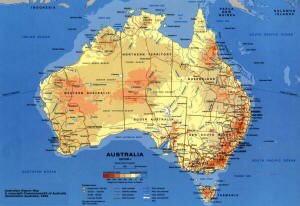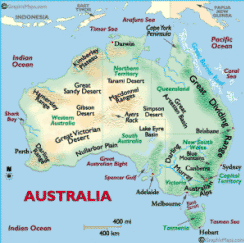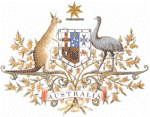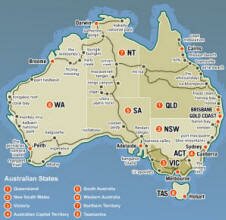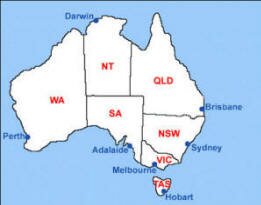|
Welcome to the eighth phase of the Around-the-World driving expedition of the World of Wonders Project. Join Kim & Don as we explore the largest island in the world - Australia. We explored Australia for over four months driving nearly 12,000 miles (19K km) beginning on July 1, 2007 in Brisbane. Come explore with us, the coastal regions where the majority of the people live, the haunting silence of the Outback, the rainforests that date back to the ancient world of Gondwanaland and the largest life form on Earth - The Great Barrier Reef. |
|
Click on either map to see it in detail |
|
| Origin of the name Australia |
Official name is "Commonwealth of Australia".
The name "Australia" is derived from the Latin Australis, meaning "of the South". Legends of an "unknown land of the south" (terra australis incognita) dating back to Roman times were commonplace in medieval geography, but were based on no actual knowledge of the continent. |
||||
|
Symbols
|
Click on each link below to learn more about the symbols.
|
||||
|
Australia is a federation of six states, two mainland territories and several minor territories
|
|
||||
| Language | Official language is English. Once there where as many as 200 Aboriginal languages, although only about 80 are currently considered to be "strong". | ||||
|
History
|
History Before the arrival of European settlers, Aboriginal and Torres Strait Islander peoples inhabited most areas of the Australian continent. It is believed that these people arrived on the continent 40,000-50,000 years ago. The first recorded European contact with Australia was in 1606, when Dutch explorer Willem Janszoon charted the west coast of Cape York Peninsula, Queensland. Later that year, Spanish explorer Luis Vaez de Torres sailed through the strait separating Australia and Papua New Guinea. Over the next two centuries, European explorers and traders continued to chart the coastline of Australia, then known as New Holland. In 1688, William Dampier became the first British explorer to land on the Australian coast. It was not until 1770 that another Englishman, Captain James Cook, aboard the Endeavour, claimed it for the British Crown. Britain decided to use its new outpost as a penal colony. The first fleet of 11 ships arrived in Sydney Harbour in January, 1788 carrying 1,500 people, half of them convicts. In all, about 160,000 men and women were brought to Australia as convicts from 1788 until penal transportation ended in 1868. The convicts were joined by free immigrants from the early 1790s on. The free settlers and former prisoners established six colonies: New South Wales (1786), Tasmania, originally called Van Diemans Land (1825), Western Australia (1829), South Australia (1834), Victoria (1851) and Queensland (1859). Various gold rushes attracted settlers, as did the mining of other minerals. Sheep farming and grain soon grew into important economic enterprises. The six colonies became states and in 1901 federated into the Commonwealth of Australia with a constitution that incorporated British parliamentary and U.S. federal traditions. Australia fought alongside Britain in World War I, most notably with the Australia and New Zealand Army Corps (ANZAC) in the Battle of Gallipoli (1915). Participation in World War II brought Australia closer to the United States when the U.S. moved to protect Australia from attack by Japan. An Aboriginal movement grew in the 1960s that gained them full citizenship and improved education for the country's poorest socioeconomic group. The right to vote was granted in 1967. In Nov. 1999, Australia's 11.6 million voters rejected a referendum that would have ended Australia's formal allegiance to the British Crown, and in Oct. 2004, John Howard won a fourth term as prime minister. For an Australian Historical Timeline, click on this link to Australian Explorer. Source: www.dfat.gov.au/aib/history, www.infoplease.com |
||||
| Government |
Government
The Commonwealth of Australia was formed in 1901 through the federation of six states under a single constitution. The non-Indigenous population at the time of Federation was 3.8 million. Half of these lived in cities, three-quarters were born in Australia, and the majority were of English, Scottish or Irish descent. While one of the first acts of the new Commonwealth Parliament was to pass the Immigration Restriction Act 1901, which restricted migration to people of primarily European origin, this was dismantled after the Second World War. Today Australia has a global, non-discriminatory policy and is home to people from more than 200 countries. Australia is a Constitutional Monarchy with the Queen of the United Kingdom the official Head of State. The Governor General, usually an Australian, represents the Queen in Australia. The Prime Minister of Australia nominates the Governor General of Australia, and the Queen ratifies the nomination. Australia has three levels of government, Federal, State and Local. Australia's Head of Government is the Prime Minister. The Prime Minister is chosen by the members of Lower House. Sources: www.dfat.gov.au/aib/history |
||||
| Economy |
Economy
Australia has a Western-style capitalist economy with a per capita GDP on par with the UK, Germany and France. Robust business and consumer confidence and high export prices for raw materials and agricultural products are fueling the economy. Australia's emphasis on reforms, low inflation, and growing ties with China are other key factors behind the economy's strength. Drought and strong import demand pushed the trade deficit up in recent years, although the trade balance improved in 2006. Housing prices peaked in 2005, diminishing the prospect that interest rates would be raised to prevent a speculative bubble. Conservative fiscal policies have kept Australia's budget in surplus since 2002.
Seventy percent of Australia’s GDP (Gross Domestic Product) comes from the service sector (including tourism, education, and financial services). The Industrial sector represents 26.2 percent of the GDP and includes: mining, transportation and industrial equipment, food processing, chemicals and steel. The main agricultural products are: wheat, barley, sugarcane, fruits, cattle, sheep and poultry and this constitutes 3.8% of the GDP. (2005 est.)
In recent decades, Australia has transformed itself into an internationally competitive, advanced market economy. It boasted one of the world’s fastest growing economies during the 1990s, a performance due in large part to economic reforms adopted in the 1980s. Long-term concerns include pollution, particularly depletion of the ozone layer, and management and conservation of coastal areas, especially the Great Barrier Reef.
The Australian dollar (A$) is a paper currency of 100 cents. There are coins of 5, 10, 20, and 50 cents and 1 and 2 dollars, and notes of 5, 10, 20, 50 and 100 dollars. A$1 = US$0.80 (US$1 = A$1.20) as of May 2007.
WEIGHTS AND MEASURES: Metric weights and measures are used.
Source: www.cia.gov/library/publications/the-world-factbook |
||||
| Geography and Climate |
Geography and Climate
The continent of Australia, with the island state of Tasmania, is approximately equal in area to the contiguous United States. Australia is the world's smallest continent and the largest island.
Mountain ranges run from north to south along the east coast, reaching their highest point in Mount Kosciusko (7,308 ft; 2,228 m). The western half of the continent is occupied by a desert plateau that rises into barren, rolling hills near the west coast. The Great Barrier Reef, extending about 1,245 mi (2,000 km), lies along the northeast coast. The island of Tasmania (26,178 sq mi; 67,800 sq km) is off the southeast coast.
The climate of Australia varies because of its large size. Generally, it is warmer and drier than the United States. Most of the continent receives only five to 20 inches of rain per year. The most steady rainfall occurs on the east coast near the Great Dividing Range and in the southwest corner of the country. Parts of the northeast, which include the tropical rainforests, have seasonal rains of up to 60 inches per year. Most summertime temperatures range between 70 degrees and 90 degrees F in the cities
Winter is mild in most of Australia. The warmest winter temperatures are in the northern portion of the country (50 degrees –80 degrees F), which is closer to the Equator. The southern area is usually colder in winter (30 degrees – 50 degrees F). In Australia, going south means traveling to a cooler region.
There are 16 Australian areas on the World Heritage List.
Sources: www.infoplease.com, www.usa.embassy.gov.au |
||||
|
Population
The Aborigines, Culture and Religion |
Population
In July of 2007, the population of Australia is estimated to be 20,434,176. The ethnic breakdown of the country is: white 92%, Asian 7%, aboriginal and other 1%. The religious breakdown is: Catholic 26.4%, Anglican 20.5%, other Christian 20.5%, Buddhist 1.9%, Muslim 1.5%, other 1.2%, unspecified 12.7%, none 15.3% (2001 Census).
All those groups of people speak: English 79.1%, Chinese 2.1%, Italian 1.9%, other 11.1%unspecified 5.8% (2001 Census).
Ethnic Groups, Culture and Religion
The term Aborigine refers to Australia's indigenous people. Recent government statistics counted approximately 400,000 aboriginal people, about 2% of Australia’s total population.
Australian Aborigines migrated from Asia at least 30,000 years ago. Though they comprise 500-600 distinct groups, aboriginal people possess some unifying links. Among these are strong spiritual beliefs that tie them to the land, a tribal culture of storytelling and like other indigenous populations, a difficult colonial history and a dislike of the term “Aborigine”, preferring to be referred to by their tribal names.
Aboriginal spirituality entails a close relationship between humans and the land. Aborigines call the beginning of the world the "Dreaming," or "Dreamtime." In the "Dreamtime," aboriginal "Ancestors" rose from below the earth to form various parts of nature including animal species, bodies of water and the sky.
Unlike other religions, however, aboriginal belief does not place the human species apart from or on a higher level than nature. Aborigines believe some of the Ancestors metamorphosed into nature (as in rock formations or rivers), where they remain spiritually alive.
The oral tradition of storytelling informs aboriginals' vibrant cultural life. Songs illustrate the Dreamtime and other tales of the land, while dances and diagrams drawn in the sand accompany oral tales.
Aboriginal music is often recognizable for its most famous instrument, the didgeridoo. A wind instrument typically made from bamboo, it extends about five feet and produces a low, vibrating hum. Aborigines use didgeridoos in formal ceremonies at such events as circumcisions and funerals.
As a result of forced assimilation in the late 1880s, most Aborigines had joined white rural and urban communities. Aboriginal people became economically marginalized and were exposed to new diseases. The consequence was massive depopulation and extinction for some aboriginal tribes.
Land and property rights fueled an important civil rights movement in the 1970s. Aborigines spoke out for equal rights, and specifically for land rights for property that had been forcibly taken by British settlers. The Aboriginal Land Rights Act, passed in 1976, became instrumental in territories with tribal associations. The 1990s witnessed further rights milestones, including government legislation that returned a great degree of autonomy, and increased wages and welfare benefits to aboriginal people.
The first National Sorry Day was held on 26 May 1998 - one year after the tabling of the report Bringing them Home which was the result of an inquiry into the removal of Aboriginal and Torres Strait Islander children from their families.
One of the recommendations of the report was that a National Sorry Day should be declared. Sorry Day offered the community the opportunity to be involved in activities to acknowledge the impact of the policies of forcible removal on Australia's indigenous populations.
In 2005 the National Sorry Day Committee renamed Sorry Day as a National Day of Healing for all Australians. The Day is designed to focus on the healing needed throughout Australian society to achieve reconciliation.
Sources: www.infoplease.com article by Ricco Villanueva Siasoco, www.cia.gov/library/publications/the-world-factbook |
||||
| Fauna and Flora |
Fauna and Flora Australia is one of the most diverse countries on the planet. It is home to more than one million species of plants and animals. About 85 per cent of flowering plants, 84 per cent of mammals, more than 45 per cent of birds, and 89 per cent of inshore, freshwater fish are unique to Australia. Many distinctive forms of plant and animal life are found, especially in the coastal and tropical areas. There are some 500 species of eucalyptus and 600 species of acacia (wattle) trees. Other outstanding trees are the baobab, blackwood, red cedar, coachwood, jarrah, Queensland maple, silky oak, and walnut. Native trees shed bark instead of leaves. Numerous types of wild flowers grow in the bush country, including boronia, Christmas bush, desert pea, flanner flower, Geraldton wax plant, kangaroo paw, pomaderris, and waratah. There are 470 varieties of orchids. About 200 kinds of mammals, 200 kinds of lizards, and 350 kinds of birds are indigenous. Apart from marsupials (bandicoots, kangaroos, koalas, possums, Tasmanian devils, tree kangaroos, and wallabies), the most unusual animals are the dingo, echidna, flying fox (fruit bat), platypus, and wombat. Birds include the anhinga, bellbird, bowerbird, cassowary, emu, galah, kookaburra (laughing jackass), lyrebird, fairy penguin, rosella, and many types of cockatoos, parrots, hawks, and eagles. Source: Encyclopedia of the Nations |
||||
| Environment |
Environment
As of 2001, 58 species of mammals, 45 species of birds, and 1,871 species of plants were threatened. Many species of trees, plants, and domestic animals have been imported, often thriving at the expense of indigenous types. Herds of wild buffalo, camels, donkeys, horses, and pigs, descendants of stock that strayed from herds imported by pioneers, roam the sparsely settled areas. The proliferation of rabbits resulted in a menace to sheep, and in 1907, a thousand-mile-long fence was built to keep rabbits out of Western Australia. Subsequently, a similar fence was erected in the east to prevent the incursion of dingos. Read here about the "Dingo Fence" the longest fence in the world. Water is considered to be a scarce resource in Australia. Problems of water quality and availability are a constant concern, although safe drinking water is available to all urban and rural dwellers. A cause for concern has been the increased salinity in the Murray Valley, caused by diverting water inland from the coast for irrigation. Pollution is the most serious problem and the vast majority of marine pollution is caused by land based activities-soil erosion, fertilizer use, intensive animal production, sewage and other urban industrial discharges. Source: Encyclopedia of the Nations, http://www.wambo.qld.gov.au/tourism/dingo.php |
||||
|
We thank our Australia Expedition Sponsors Please visit their websites
|
